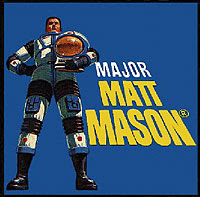 |
| Photo from National Geographic, March 1964 |
Article by Paul Vreede
Major Matt Mason and crew are wearing spacesuits based on the AX1L series of experimental suits made by ILC for NASA in the early 1960s. (A denoting Apollo, X experimental and L being NASA's code for ILC in this case)
International Latex Corporation was founded in 1937 by Abram Nathanial Spanel, based in Dover, Delaware. Producing all sorts of rubberized products (incl rubber attack boats, life rafts and canteens during WW2), the company became famous after the war for producing Playtex ladies' garments. Its Government and Industrial Division produced pressure suits for the US Air Force and Navy, and eventually anticipated a need for space suits.
An experimental suit for the X-15 programme wasn't adopted by the Air Force in 1955, but made enough of an impression that various Air Force development contracts came the company's way. And when NASA requested proposals for a space suit by the end of 1961, ILC won with their AX1L design, beating seven other contenders.
 |
| An AX1L suit held by the Smithsonian, credit see note 2 below |
One of the prime features of ILC suits were the latex-dipped joints which provided a maximum of mobility for the wearer when the suit was pressurized. The suit being filled with oxygen, the rigid-but-flexible joints allowed this to move unrestricted when the wearer would flex a knee, elbow or shoulder instead of ballooning and getting in the way. This is well illustrated in period footage, where the wearer can move about in the suit with no apparent restriction (note SPD-143 is ILC's own designation for their development suit after winning the contract - NASA used the AX1L designation for the initial suit as well as a number of following development versions)
In the National Geographic photo the joints on the suit can be clearly seen. They would subsequently get an extra fabric cover on the outside hiding them from view, and following versions of the pressure suit would be worn inside an extra protective garment. Further development added a water-cooled inner garment and other enhancements but the Apollo suits worn in space and on the Moon all derive from the SD1X.
Whether Mattel designers Jack Ryan and Ralph Dunn saw the AX1L suit in National Geographic or elsewhere, the distinctive joints did for their toy figure what they also did for the real life suit: improved movement. By representing the joints with wide round fins on a thinner section of rubber, an impression of volume was created while having much less rubber to bend and keep in place by the wire armature inside each figure's limbs.
Paul's Notes
 |
|
- Photo at top of page is from National Geographic magazine of March 1964, part of an extensive article on the developing Apollo program.
- AX1L photo © the National Air and Space Museum / Smithsonian, included here for educational purposes as permitted by their terms of use. Source page here.
- There's a nice document by ILC about their Apollo suits on the ASME site here.
- This link seems to work for more footage of the SPD-143 suit on YouTube without too much other stuff spoiling the results.
Text on this page © Paul Vreede 2024 - images on this page © their respective owners, used for educational purposes only. All other content, including images and editorial, is Copyright © 1997-2024 John Eaton and/or contributors unless otherwise stated. If there are any comments or objections, please contact John Eaton.







No comments:
Post a Comment